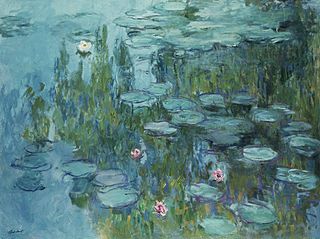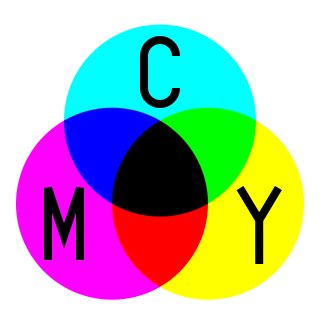Related Research Articles

In computing, a printer is a peripheral device which makes a persistent representation of graphics or text, usually on paper. While most output is human-readable, bar code printers are an example of an expanded use for printers. The different types of printers include 3D printer, inkjet printer, laser printer, thermal printer, etc.

Cyan is a greenish-blue color. It is evoked by light with a predominant wavelength of between 490 and 520 nm, between the wavelengths of green and blue.

Electronic paper, also sometimes electronic ink or electrophoretic display, are display devices that mimic the appearance of ordinary ink on paper. Unlike conventional flat panel displays that emit light, electronic paper displays reflect light like paper. This may make them more comfortable to read, and provide a wider viewing angle than most light-emitting displays. The contrast ratio in electronic displays available as of 2008 approaches newspaper, and newly (2008) developed displays are slightly better. An ideal e-paper display can be read in direct sunlight without the image appearing to fade.

Ink is a gel, sol, or solution that contains at least one colourant, such as a dye or pigment, and is used to color a surface to produce an image, text, or design. Ink is used for drawing or writing with a pen, brush, reed pen, or quill. Thicker inks, in paste form, are used extensively in letterpress and lithographic printing.

Screen printing is a printing technique where a mesh is used to transfer ink onto a substrate, except in areas made impermeable to the ink by a blocking stencil. A blade or squeegee is moved across the screen to fill the open mesh apertures with ink, and a reverse stroke then causes the screen to touch the substrate momentarily along a line of contact. This causes the ink to wet the substrate and be pulled out of the mesh apertures as the screen springs back after the blade has passed. One colour is printed at a time, so several screens can be used to produce a multi-coloured image or design.

A set of primary colors is a set of colorants or colored lights that can be combined in varying amounts to produce a gamut of colors. This is the essential method used in applications that are intended to elicit the perception of diverse sets of color, e.g. electronic displays, color printing, and paintings. Perceptions associated with a given combination of primary colors are predicted by applying the appropriate mixing model that embodies the underlying physics of how light interacts with the media and ultimately the retina.
Magenta is a colour that is variously defined as purplish-red, reddish-purple or mauvish-crimson. On colour wheels of the RGB (additive) and CMY (subtractive) colour models, it is located exactly midway between red and blue. It is one of the four colours of ink used in colour printing by an inkjet printer, along with yellow, black, and cyan, to make all other colours. The tone of magenta used in printing is called "printer's magenta".

Inkjet printing is a type of computer printing that recreates a digital image by propelling droplets of ink onto paper and plastic substrates. Inkjet printers are the most commonly used type of printer, and range from small inexpensive consumer models to expensive professional machines.

Dye-sublimation printing is a computer printing technique which uses heat to transfer dye onto materials such as a plastic, card, paper, or fabric. The sublimation name was first applied because the dye was considered to make the transition between the solid and gas states without going through a liquid stage. This understanding of the process was later shown to be incorrect, as there is some liquefying of the dye. Since then, the proper name for the process has become known as dye-diffusion, though this technically-correct term has not supplanted the original name. Many consumer and professional dye-sublimation printers are designed and used for producing photographic prints, ID cards, clothing, and more.

Paperboard is a thick paper-based material. While there is no rigid differentiation between paper and paperboard, paperboard is generally thicker than paper and has certain superior attributes such as foldability and rigidity. According to ISO standards, paperboard is a paper with a grammage above 250 g/m2, but there are exceptions. Paperboard can be single- or multi-ply.

Stippling is the creation of a pattern simulating varying degrees of solidity or shading by using small dots. Such a pattern may occur in nature and these effects are frequently emulated by artists.

Subtractive color, or "subtractive color mixing", predicts the spectral power distribution of light after it passes through successive layers of partially absorbing media. This idealized model is the essential principle of how dyes and inks are used in color printing and photography where the perception of color is elicited after white light passes through microscopic "stacks" of partially absorbing media allowing some wavelengths of light to reach the eye and not others.

Security printing is the field of the printing industry that deals with the printing of items such as banknotes, cheques, passports, tamper-evident labels, security tapes, product authentication, stock certificates, postage stamps and identity cards. The main goal of security printing is to prevent forgery, tampering, or counterfeiting. More recently many of the techniques used to protect these high-value documents have become more available to commercial printers, whether they are using the more traditional offset and flexographic presses or the newer digital platforms. Businesses are protecting their lesser-value documents such as transcripts, coupons and prescription pads by incorporating some of the features listed below to ensure that they cannot be forged or that alteration of the data cannot occur undetected.

RYB denotes the use of red, yellow, and blue pigments as primary colors in art and applied design. Under traditional color theory, this set of primary colors was advocated by Moses Harris, Michel Eugène Chevreul, Johannes Itten and Josef Albers, and applied by countless artists and designers. The RYB color model underpinned the color curriculum of the Bauhaus, Ulm School of Design and numerous art and design schools that were influenced by the Bauhaus, including the IIT Institute of Design, Black Mountain College, Design Department Yale University, the Shillito Design School, Sydney, and Parsons School of Design, New York.
Color printing or colour printing is the reproduction of an image or text in color. Any natural scene or color photograph can be optically and physiologically dissected into three primary colors, red, green and blue, roughly equal amounts of which give rise to the perception of white, and different proportions of which give rise to the visual sensations of all other colors. The additive combination of any two primary colors in roughly equal proportion gives rise to the perception of a secondary color. For example, red and green yields yellow, red and blue yields magenta, and green and blue yield cyan. Only yellow is counter-intuitive. Yellow, cyan and magenta are merely the "basic" secondary colors: unequal mixtures of the primaries give rise to perception of many other colors all of which may be considered "tertiary."
Soy ink is a kind of ink made from soybeans. As opposed to traditional petroleum-based ink, soy-based ink is presumed to be more environmentally friendly, might provide more accurate colors, and makes it easier to recycle paper. It is slower to dry than many inks.

Textile printing is the process of applying colour to fabric in definite patterns or designs. In properly printed fabrics the colour is bonded with the fibre, so as to resist washing and friction. Textile printing is related to dyeing but in dyeing properly the whole fabric is uniformly covered with one colour, whereas in printing one or more colours are applied to it in certain parts only, and in sharply defined patterns.
A variety of tests are used to determine ink and paper and paperboard quality, and to measure their interactions. They are necessary to balance print quality, cost, and wear on the press. Some of the important paper and ink tests are listed here:
Lightfastness is a property of a colourant such as dye or pigment that describes how resistant to fading it is when exposed to light. Dyes and pigments are used for example for dyeing of fabrics, plastics or other materials and manufacturing paints or printing inks.
The surface chemistry of paper is responsible for many important paper properties, such as gloss, waterproofing, and printability. Many components are used in the paper-making process that affect the surface.